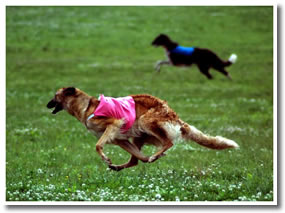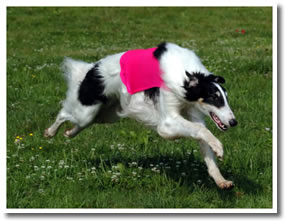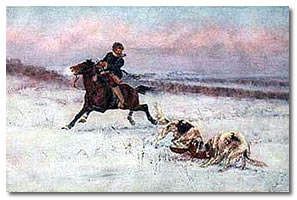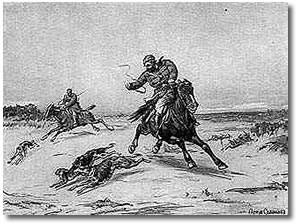|
close
window

Outeshai, 1895.
Winner of the hare-coursing prize at Colombiagi (near St. Petersburg)
two years in succession.
Known
here prior to 1936 as the Russian Wolfhound, the Borzoi is a sighthound
dependent on his extreme speed, agility and courage to pursue, overtake
and hold the quarry.
In
Russia, the precursors of the Borzoi were thought to be of several different
types including the long-coated, smooth-faced bearhound of early Russia,
the Southern coursing hounds of the Tatars, the Owtchar, as well as other
ancient sighthound types. Whatever the Borzoi origin, by 1260 the coursing
of hare for sport is mentioned in connection with the Court of the Grand
Duke of Novgorod at the time of the First Czar.
|
|
 photographer:
Shot On Site
photographer:
Shot On Site |
From
the time of the first Czars hunting with Borzois reached the level of
the national sport of the aristocracy. Large rural estates of thousands
of acres with hundreds of serfs were given over to the breeding, training
of and hunting with Borzoi. In 1861 serfdom was abolished but the hunts
continued, to a lesser extent until the Russian Revolution in 1917. Time,
effort and money that was expended on these "hunts" is surely
unequaled in the development of any other breed.
|
 photographer:
Shot On Site
photographer:
Shot On Site |
 Grand Duke
Nicholas
Grand Duke
Nicholas |
Due to many experimental
outcrosses in the breed only a few Borzois of the old type existed by
1873. In that year the Imperial Association was formed to protect and
promote this ancient type. Due to this Association many bloodlines of
Borzois in America today can be traced back to breeders who were members
of this group, most notable, Grand Duke Nicholas and wealthy landowner
Artem Boldareff. It is to their hunts at Perchino and Woronzova that
many of today's Borzois owe their heritage.
The Borzoi today
remains largely unchanged from his Russian ancestors, both in terms
of his appearance, his quiet, gentle nature and his abilities.
|

photographer:
Shot On Site
 photographer:
Shot On Site
photographer:
Shot On Site |

photographer:
Shot On Site
While
the hunt has been the primary purpose of the Borzoi, his beauty and
temperament were also always of prime importance. He was always a companion
par excellence and a favorite of the salon.
|
|

|
Though
the circumstances of the Borzoi have changed from those of Czarist Russia,
they remain true aristocrats. While he needed particular structural
qualities to chase, catch and hold his quarry with special emphasis
on a sound running gear, strong neck and jaws, courage and agility with
proper condition, the Borzoi should always possess unmistakable elegance,
with flowing lines, graceful in motion or repose.
TOP
|










